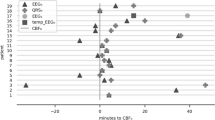Abstract
This article reports a patient with an endocardial pacemaker undergoing a carotid endarterectomy in whom cerebral function was monitored by using processed electroencephalography (EEG). The EEG was processed by means of aperiodic analysis. The pacemaker generated an artifact that was identified on the processed EEG display and on the raw EEG display. During the time of carotid cross-clamping, a loss of EEG activity was noted on careful examination of the processed EEG and confirmed by referring to the raw EEG. Nevertheless, because of the presence of the artifact, the activity edge remained essentially constant despite the change in underlying EEG activity. The cross-clamp was released based on the observed change in EEG activity, yielding a return to baseline EEG activity. The surgeon elected to shunt the patient. The patient awoke without neurologic sequelae. This case serves to demonstrate the importance of referring to the raw EEG signal and the limitations of the activity edge in the presence of artifact.
Similar content being viewed by others
References
Sundt TM, Sharbrough FW, Piepgras DG, et al. Correlation of cerebral blood flow and electroencephalographic changes during carotid endarterectomy. Mayo Clin Proc 1981;56:533–543
Sundt TM, Sharbrough FW, Anderson RE, Michenfelder JD. Cerebral blood flow measurements and electroencephalograms during carotid endarterectomy. J Neurosurg 1974;41:310–320
Rampil IJ, Holzer JA, Quest DO, et al. Prognostic value of computerized EEG analysis during endarterectomy. Anesth Analg 1983;62:186–192
Gregory TK, Pettus DC. An electroencephalographic processing algorithm specifically intended for analysis of cerebral electrical activity. J Clin Monit 1986;2:190–197
Spackman TN, Faust RJ, Cucchiara RF, Sharbrough FW. A comparison of aperiodic analysis of the EEG with standard EEG and cerebral blood flow for detection of ischemia. Anesthesiology 1987;66:229–231
Levy WJ. Intraoperative EEG patterns: implications for EEG monitoring. Anesthesiology 1984;60:430–434
Author information
Authors and Affiliations
Rights and permissions
About this article
Cite this article
Clark, S., Goldberg, M., Gorman, R. et al. Interference of automated electroencephalographic processing by an endocardial pacemaker. J Clin Monitor Comput 5, 22–25 (1989). https://doi.org/10.1007/BF01618366
Received:
Revised:
Accepted:
Issue Date:
DOI: https://doi.org/10.1007/BF01618366




